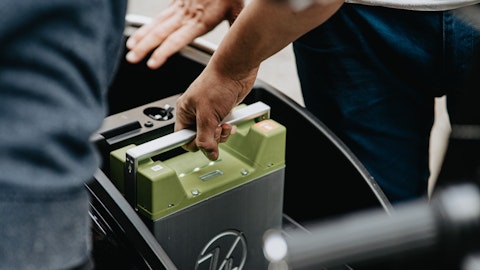FMC Corporation (NYSE:FMC) Q3 2023 Earnings Call Transcript October 31, 2023
Operator: Good morning, and welcome to the Third Quarter 2023 Earnings Call for the FMC Corporation. This event is being recorded and all participants are in a listen-only mode. [Operator Instructions] I would now like to turn the conference over to Mr. Zack Zaki, Director of Investor Relations for FMC Corporation. Please go ahead.
Zack Zaki: Thank you, Ledia, and good morning, everyone. Welcome to FMC Corporation’s third quarter earnings call. Joining me today are Mark Douglas, President and Chief Executive Officer; and Andrew Sandifer, Executive Vice President and Chief Financial Officer. Mark will review our third quarter performance as well as provide an outlook for fourth quarter and full year performance. Followed by an update on FMC, Diamides franchise. Andrew will provide an overview of select financial results. Following the prepared remarks, we will take questions. Our earnings release and today’s slide presentation are available on our website, and the prepared remarks from today’s discussion will be made available after the call. Let me remind you that today’s presentation and discussion will include forward-looking statements that are subject to various risks and uncertainties concerning certain factors, including, but not limited to, those factors identified in our earnings release and in our filings with the Securities and Exchange Commission.

A chemical engineer studying a lab sample of a food product for safety regulations.
Information presented represents our best judgment based on today’s understanding. Actual results may vary based upon these risks and uncertainties. Today’s discussion and the supporting materials will include references to adjusted EPS, adjusted EBITDA, adjusted cash from operations, free cash flow and organic revenue growth, all of which are non-GAAP financial measures. Please note that, as used in today’s discussion, earnings mean adjusted earnings and EBITDA means adjusted EBITDA. A reconciliation and definition of these terms as well as other non-GAAP financial terms to which we may refer during today’s conference call are provided on our website. With that, I will now turn the call over to Mark.
Mark Douglas: Thank you, Zack. And good morning, everyone. During Q3, we observed a continuation of industrywide destocking activity as the value chain resets inventory levels in response to increased security and supply and high interest rates. This led to significantly lower volumes versus the prior year and in the case of Latin America, the decline was much more severe than we had estimated at our last earnings call. As a reminder, due to the timing of its growing season Latin America is typically the strongest contributor to our Q3 results which amplifies the region’s impact on our overall Q3 numbers. We had assumed that the destocking we observed in Latin America during Q2 would be sufficient to allow for our normal order patterns to resume.
As Latin America entered its main growing season in September, it became clear that we underestimated the debt and duration of the destocking to come. It is our view that when the global destocking ends and channel inventories have been reset, there will not be a snapback restocking period. Rather, we expect the crop protection market will grow from that reset inventory base at a more historical growth rate. As a result, and as we noted in our pre-release, we are taking significant actions with regards to our company’s cost structure, with an announced restructuring of our Brazilian operations, as well as a review and adjustment of our total company cost base. We are right-sizing our cost base to better reflect market conditions, protect our margins, and position us for future success.
We will provide more details about our restructuring programs at our Investor Day. Our Q3 results are detailed on slides 3, 4 and 5. Q3 revenue was 29% lower than the prior year, both including and excluding FX, driven primarily by lower volumes from channel destocking and, to a lesser extent, dry weather conditions in some countries. We had price increases in North America, EMEA, and Asia, which were more than offset by price decreases in Latin America. While our sales were down significantly versus prior year, we need to be clear that the grower application of crop protection products has been steady, and even trend in higher than the prior year in some key countries such as Brazil and the US. In addition, sales of our newer and more differentiated products, including Branded Diamides and Plant Health, outperformed the overall portfolio.
Products launched in the last five years grew 4% and represented 10% of total sales in the quarter, demonstrating robustness in the current environment. New product launches accounted for more than 4% of total company sales in the quarter. Looking at our revenue by region, North America sales were lower than the prior year by 34% as anticipated destocking activity was the main driver of lower volumes. Dry weather in Canada was a smaller volume headwind. Sales in EMEA were relatively flat with a revenue decline of only 1% and 4% excluding FX. We encountered volume pressure from channel destocking as expected particularly in Germany. This was mostly offset by a combination of higher prices, strong diamide sales that outperformed the overall portfolio and a modest FX tailwind.
In Latin America sales were down 33%, 36% excluding FX due to lower volumes and to a lesser degree pricing pressure. Destocking particularly in Brazil and Argentina was the driver of the results in the region. At the same time, we had a very successful launch of our patent pending diamide insecticide Premio Star in Brazil. The strength of that launch was one reason branded diamide strongly outperformed the rest of the region’s portfolio. Shifting to Asia, sales were down 28% and 23% organically. As expected, from like the other regions, volumes were negatively impacted by destocking behavior, particularly in India, where elevated channel inventory continues to be actively managed. Pricing was up slightly with an FX headwind. Products launched in the last five years showed greater resilience than the rest of the portfolio and grew 16% versus the prior year, driven by sales of Isoflex herbicide.
The outperformance of new products in most regions demonstrates how our technology differentiates FMC in the marketplace and why our new product pipeline is a key contributor to our growth at consistently superior margins. We reported EBITDA of $175 million in the quarter, down 33% compared to the prior year period, due to the volume decline along with a smaller pricing headwind partially offset by lower costs. Sales of new products included launches and sales of differentiated products such as our branded diamide and biologicals positively impacted mix. Costs were $137 million tailwind, with contribution from inputs and to a lesser degree operating costs. Input cost benefits were especially pronounced compared to the prior year period that represented the peak of inflationary headwinds.
Combined SG&A and R&D costs were favorable to prior year, and we are on track to deliver our commitment of $60 million to $70 million cost control in the second half, keeping those operating costs in line with the prior year. Shifting to our outlook, slide 6 shows our latest expectations for Q4 and full year. We are expecting revenue in Q4 to be 22% lower than the prior year, driven by a high teens percentage volume decline, as destocking continues. Similar to Q3, we expect a low to mid-single-digit pricing headwind in Q4, driven by Latin America. FX impact is forecasted to be minimal. Adjusted EBITDA in Q4 is expected to be between $246 million and $306 million, which is a 36% year-over-year decline at the midpoint, primarily due to lower volumes.
We expect positive mix impact as sales of new products, including launches, continue to show growth. Operating costs are expected to be in line with the prior year as cost controls remain in place. I’ll now turn the call over to Andrew, who will cover cash flow and other financial topics.
Andrew Sandifer: Thanks, Mark. I’ll start this morning with a review of some key income statement items. FX had essentially no impact on revenue in Q3, with headwinds among Asian currencies, particularly the Pakistani Rupee and the Indian Rupee, offset by tailwinds in Latin American and European currencies, particularly the Brazilian Real, the Mexican Peso, and the Euro. EBITDA margin in the quarter was down 120 basis points versus the prior year period. While favorable input costs and positive mix led to a gross margin percent that was over 400 basis points higher than the prior year period, the severity of the volume decline resulted in a decline in EBITDA margin. EBITDA margins in Q4 are expected to be meaningfully below prior year and prior guidance.
Gross margin is anticipated to be challenged by pricing pressures in Latin American, Asia due to current market conditions. Despite continued operating cost discipline, the expected decline in volume is anticipated to further pressure EBITDA margin, as SG&A and R&D expenses are supported by a lower revenue base. Interest expense for Q3 was $65 million, up $23 million from the prior year period. The significant increase in US interest rates year-over-year with the main driver. Higher overall debt levels also contributed to increased interest expense as working capital remains elevated. Relative to guidance, elevated interest expense was entirely attributable to higher debt balances. We now expect full-year interest expense to be in the range of $240 million to $245 million, with the increased versus prior guidance due to elevated working capital levels resulting in higher debt balances.
Our effective tax rate on adjusted earnings for Q3 was 15%, in line with the midpoint of our full-year expectation for a tax rate of 14% to 16%. Moving next to balance sheet and liquidity. As of September 30th, gross debt-to-EBITDA was 3.6x, while net debt-to-EBITDA was 3.3x, reflecting the sudden deceleration of our earnings beginning in Q2 and elevated debt levels due to higher working capital resulting from this deceleration. The covenant of our revolving credit facility evaluated our leverage using a metric that includes adjustments to both EBITDA and debt as reported. With these adjustments, covenant leverage was 3.8x as of September 30th, relative to a maximum allowable of 4.0x. We do not view this as an acceptable leverage level relative to our covenant.
In light of this and the reduced outlook for Q4, we are currently in advanced discussions with our bank group to further amend our covenant to provide additional headroom for the company as we adjust our cost structure and debt levels to current market realities. Our bank group continues to be highly supportive of the company and recognizes the transitory nature of the current industrywide channel inventory correction. We expect to complete this amendment in the next 7 to 10 days and will provide further updates at time. Moving on to cash flow generation and deployment on slide 7. FMC generated free cash flow of $32 million in Q3, down from $360 million in the prior year period. Cash from operations declined $316 million with lower EBITDA and substantially lower payables as we adjust our operations to match current demand.
Capital additions and other investing activities were slightly lower than the prior year period while legacy spending increased $14 million due to timing of expenses. Year-to-date cash flow through September 30th was negative $790 million, $651 million lower than the prior year period. Nearly all of the reduction stems from lower cash from operations, which was down substantially due to lower EBITDA and lower payables. We returned $73 million to shareholders in the quarter via dividends. There were no share repurchases in Q3. We expect full-year weighted average diluted shares outstanding to be $125.7 million. We’ve reduced our free cash flow guidance for 2023 to negative $750 million at the midpoint. Down from breakeven in our previous guidance.
The reduction in full-year cash flow outlook is a direct result of lower than expected second half EBITDA and the impact of reduced volume on working capital. Compared to prior year, the decline in free cash flow is almost entirely due to lower EBITDA and payables. With lower use of cash for inventory, largely offsetting other items including higher cash interest, cash taxes and capital investment. Adjusted cash from operations is now expected to be between negative $635 million and negative $435 million, down substantially from prior guidance. Capital additions are expected to be between $135 million and $145 million including spending to support new product introductions, which is our most recent results illustrate, drive high value for our business even in challenging industry conditions.
Legacy and transformation cash spending of $70 million to $80 million is expected to remain essentially flat to midpoint after adjusting for the benefit from the disposal of an inactive site in 2022. This guidance implies a rolling three year average free cash flow conversion of 21%, substantially below our targeted 70 plus percent. This is due entirely to the cash flow and books impacts from the inventory reset in 2023. I’ll reiterate Mark’s earlier point that end market demand for our products is solid. The quality of our receivables is solid with good performance on collections in key countries including Brazil. Once this industrywide channel inventory reset is finished and more normal order patterns resume, we expect a significant rebound in cash flow as EBITDA improves, inventory is converted to receivables which are subsequently collected and critically as we rebuild payables ramping back up production.
Our near term cash deployment priorities have not changed with the dividend and debt reduction including the redemption in Q4 of the $400 million in notes due in 2024, still the top priorities. Share of purchases will remain suspended until leverage returns sustainably to targeted level. And with that, I’ll hand the call back to Mark.
Mark Douglas: Thanks, Andrew. I mentioned earlier that our more differentiated products were showing resilience in the current market environment. This includes the Diamides, a very successful product franchise, which has received renewed attention over the last couple of months. Today, I’ll give you an update on the progress of our Diamides growth strategy. This will be supplemented by our forward-looking view of the robust growth plans we have for the Diamides at our Investor Day. We have owned the Diamides for the past six years. Over this timeframe, we have delivered on every target we’ve set, including growing the size of the business, expanding our partner base, accelerating registrations, expanding our geographic footprint, and finally, introducing brand new patented formulations that allow us to explore and expand the new market segments.
All of these results should provide confidence that we can continue to profitably grow the franchise into the future. Turning to slide 9 for some basic data on the insecticides market, which was valued at over $20 billion in 2022. Insecticides have grown at roughly 5% per year over the current time frame. FMC’s Diamides, Rynaxypyr and Cyazypyr, make up more than 80% of the entire Diamides class, which includes a few other smaller active ingredients. FMC’s Diamides have grown at about 12% of the total insecticide market. And as you can see, Diamides outperformed every other leading chemistry class in the insecticide market by growing at 11% compound annual growth rate and gained 5% market share as a result. High value technologies such as the Diamides continue to take share from older insecticides, some of them being phased out by regulators.
Turning to slide 10, we showed a breakdown of our $2.1 billion of Diamides sales in 2022. Cyazypyr has grown more rapidly than Rynaxypyr since our acquisition of the assets and made up more than 20% of total sales. This year, we estimate that this trend will continue, with Cyazypyr making up roughly 22% of total Diamides sales. Partner sales are a key element of our lifecycle management strategy. FMC sells either technical active ingredient or formulated products to our partners under these arrangements. We have long-term supply agreements with five key global companies and over 60 local agreements in various countries with the potential to add more partners in the future. Many of these agreements go through the end of the decade. The partnership model has helped to expand the market for our Diamides since our partners have access to customers, crops and segments that we do not currently serve.
Moreover, partner sales are not margin dilutive and these sales made up roughly one-third of our Diamides revenue in 2022. While the remaining two-thirds came from our own commercial activities, which we refer to as branded sales. In 2023, we’ve seen our partners actively manage their inventories, resulting in lower sales. Branded sales have continued to outperform the overall company. We’ve also shown the geographic breakdown of our branded sales as of 2022. Asia made up more than 40% of our branded sales, followed by Latin America at 28%, EMEA at 17%, and North America at 12%. This year, we expect branded sales to outperform total sales in Latin America, driven by new products’ introductions. Branded Diamides in the other regions are expected to perform in line with, or better than, respective regional sales.
On the right to the crop breakdown of our overall Diamides revenue, which includes branded and partner sales. The diversity of crops reflects the broad market potential, as well as market access required to sell these products. This is an important fact to note, as we have numerous products selling in more than 90 countries across dozens of crops. Our Diamides are not a single monolithic product, and as such are defendable through various mechanisms, including, most importantly, newly patented formulations, branding, value selling, agronomic support, and grower education. Our precision ag offering, Arc farm intelligence, now helps support and defend over $700 million of revenue from our branded Diamides, a unique and powerful tool in our Diamides growth strategy.
Turning to Slide 11, you can see that managing the Diamides life cycle has multiple strategic components. We will provide more color on these pillars at Investor Day in November, but I wanted to start framing the innovation and IP pillars today. Turning to slide 12, FMC has continued to significantly grow the Diamides to innovation, since acquiring them in late 2017. At acquisition, sales were already segmented across dozens of formulations and brands, spread across more than 80 countries. Since acquisition, FMC has increased the segmentation by developing new partner sales, launching new patented formulations and brands, obtaining new registrations and expanding existing labels which have resulted in a diverse portfolio. This diversity minimized reliance on any single formulation and instead relies on innovation to drive future growth.
We have already started to see the benefits of recent innovation in Diamides. This is evident from the increase in total sales of Branded Diamides from ‘21 to ‘22, even though some of the core Rynaxypyr products decline modestly in the same time frame. Coragen MaX insecticide powered by Rynaxypyr is one example of innovation that did not exist when we acquired the Diamides. Coragen MaX is a patent pending higher concentration formulation of Coragen that provides targeted insect control in canola, pulses and cereals. Premio Star is another example of new technology that was developed primarily for applications on Brazilian soy, corn and citrus crops and receive priority approval from Brazilian authorities. The patent-pending combination of Rynaxypyr and bifenthrin provides a differentiated formulation with extremely high performance for chewing and sucking insects.
Premio Star has a dual mode of action, its broad spectrum, with both immediate and extended control. FMC has developed and launched four new patented or patent-pending formulations across 10 countries in the past few years. These new technologies are expected to make up 17% of branded Diamides sales in 2023. Contributions from new products will further accelerate over the next few years, removing FMC’s portfolio away from older and less differentiated products. Slides 13 and 14 show an updated view of our patent and regulatory timelines. FMC has a patented state of over 1,000 granted and pending patents filed in over 75 countries for the Diamides. While we have not changed our overall outlook, we have included additional commentary to reflect developments since we last shared these timelines.
One addition from our last version of this slide is the inclusion of patented mixtures and patent-pending formulations that can extend patent coverage once granted to 2040 and beyond in some cases. Patents are regulated by different government entities than the ones that issue crop protection registrations. Approvals of registrations does not have any bearing on patent validity. Generally speaking, legal actions must be initiated by the patent holder and can only start after registration is received and a generic product enters into commercialization. Moreover, patent judgments in one country do not change FMC’s patent rights in other countries. Nor do these judgments give companies the freedom to operate in other countries with valid patents in place.
FMC will continue to enforce our patents and we view any infringing parties as a seller of illegal product. In addition to our legal strategy, we also have a regulatory advocacy strategy that includes the enforcement of our data protection rights and notifying regulators about companies that do not have permission to produce or have unknown or different impurities in their products, or otherwise do not comply with applicable regulatory law. This has been and continues to be a successful strategy. Numerous regulatory authorities have declined to approve registrations from such companies. In other instances, companies have voluntarily cancelled or withdrawn applications as a result of our efforts. Hopefully this overview has provided a more comprehensive understanding of the current state of FMC’s Diamides.
At or Investor Day, we will provide a view of the next phase of growth for this franchise, driven by innovation and other strategic levers. Finally, let me wrap up by saying that 2023 has clearly not turned out how we or the broader industry thought it would. However, we firmly believe the current channel destocking will run its course, and I believe we have taken the right actions to reflect what is happening from a channel demand standpoint. Our new products, Plant Health products, and Branded Diamides all continue to outperform the rest of the portfolio, which shows the benefit of our technology investments. We look forward to seeing many of you at our Investor Day where we will lay out our new strategic plan and provide an outlook for FMC’s growth over both a near and long term.
We can now open the line for questions.
See also 11 Best Military Drone Stocks To Invest In and 15 Worst Performing Industries in 2023.
Q&A Session
Follow Fmc Corp (NYSE:FMC)
Follow Fmc Corp (NYSE:FMC)
Operator: Our first question today comes from Joel Jackson of BMO.
Joel Jackson: Hey, good morning, everyone. There are a lot of questions in FMC, obviously, the last weeks, last months on the near term outlook and then, of course, the midterm outlook with the diamides and other products. Maybe we could start with next year. I realize it’s early, but it’s a key question. We had a lot of volatility around the different numbers. When you think about 2024, can you help anchor us on what it might look like? I don’t know if you want to use your 7% to 9% EBITDA placeholder target as a starting point and as granular as possible around volumes, costs, price, where do you think earnings growth can shake out next year? What do you have to do to get the inventory out of the system? Do you have to lower prices? Whatever you can do to help us, get an early look on 2024. Be appreciative.
Mark Douglas: Yes, thanks, Joel. Listen, you are right, it is a little early to be giving specific details and we will talk more about this at our Investor Day as you can imagine. But let me try and frame ‘24 in the context of where we are today, give you some idea of how we’re thinking. We have gone through obviously since sort of mid-year a very significant inventory reset and I’ll keep reiterating the point that we see this as destocking inventory reset, whatever you want to call it, it does not reflect on the ground demand. We see strong on the ground demand pretty much everywhere in the world which is the backdrop for how the business really recovers and comes out of this period. The resetting is occurring now, obviously we started in Q2, we entered Q3 and here we are in Q4 and it’s still ongoing.
I would say next year Q1 is going to be more difficult because the inventory had not reset so Q1, 2023 was a pretty good quarter kind of flattish to 2022. That’s not going to be the case. We’re going to see that inventory reset continue in Latin America, likely in Europe as well, and maybe even a little bit in the US. We’ll see how we go through Q4. I think things will start to change in Q2 as we start to lack the industry reset. And then I expect the industry to move forward in the second half of the year. I know some people will say it’s going to be a first half, second half story. It is just because of the way the seasons are moving and the inventory is resetting. From our perspective, I see revenue growth next year for FMC, and I see higher than revenue, EBITDA growth and revenue for next year.
Why do I say that? I think the second half of next year is going to be much better. I think the industry will be in a much more balanced shape. As I’ve said, we’re not expecting a snapback. I just don’t see with the current economic environment where I see supply and where I see interest rates. I don’t see people going and building a significant inventory again. That’s not necessarily a bad thing. The industry typically grows at 3 plus percent a year. I expect you’re going to see something like that number in the second half of the year. For us, new products continue to be a major driver. One reason why we’re very excited about next year is we have more products coming. And right now, when you look at what we call our NPI data, we’re having something like $630 million this year of new business from those products launched in the last five years.
I expect that number to be higher next year, adding more revenue to the company. So we see the new products paying off as we go over the next few years. From a cost perspective, I’ll let Andrew comment a little bit on costs. We do have a couple of elements flowing through the P&L and balance sheet right now. Not only do we have cost savings, but we have unabsorbed variances coming out of our manufacturing plants as we think about the length of time that those manufacturing plants are either shut or idle and until they come back. So you’ve got to factor that in as we go next year. Having said that, we are putting in place significant restructuring plans. That will benefit EBITDA next year, as well as the product mix benefits EBITDA and gross margin.
Andrew, do you want to say anything on the cost side?
Andrew Sandifer: Yes, just echo comments you made, Mark, I think, as we look forward to input cost for next year. The cost of what limited buying we’re doing right now, but the cost of things that we’re buying are in a positive comparison to prior year. We do expect that input cost will be a modest tailwind next year. The challenge is, unfortunately, that carried forward of unabsorbed fixed costs from reduced production and then the latter part of this year and into early next year. So at gross margin, we’re not expecting a lot of help either way at the gross margin line from input cost. Being offset again by unabsorbed fixed costs. It really would be the impact of the cost savings programs we’re in the process of launching that will impact every line of the P&L from COGS to SG&A and R&D. We’ll detail this more, additional detail at our Investor Day in a few weeks, but that will be a big part of driving profit growth next year.
Mark Douglas: So Joel, to wrap up for you, expect to see revenue growth, expect to see EBITDA growth above revenue growth next year from FMC.
Joel Jackson: Great. That’s helpful. And then you reiterated a lot of your plan to defend the Diamides across the decade. As you’ve started doing some of these moves, can you talk about what’s going well, what’s not going as well as you’ve thought in some of these strategies and how you’re thinking about changing them? And if you can be as granular as possible, what’s working and not working in the different countries like India, Brazil, wherever else it’d be helpful.
Mark Douglas: Yes, sure. I mean, first of all, our main strategy, I think it’s on slide 12, which shows the sediment chart. You can see on that slide how we’re altering the profile of the portfolio of the Diamides. The new products are growing rapidly. The one we mentioned in the script, Premio Star in Brazil, that has already contributed in Q3, tens of millions of dollars of new growth. And we expect to see the same in Q4 and as we go forward in the rest of the season. That’s the type of activity that changes the face of the Diamides. First of all, they give you tremendous pattern extension because these are very sophisticated formulations, whether it’s the blend of different active ingredients or something like Coragen MaX, which is a very high concentration formulation.
It means you can use less; it means you’re carrying less water, less packaging. So from a sustainability perspective, it’s a great product and it also has superb efficacy. So it’s those types of innovations, not only change what we sell, it may move us away from any generic products that will come into the market, either legally or illegally in different countries. It changes the shape and it adds more value to the company. So I think from a product innovation standpoint, that’s one aspect that we’ve been heavily focused on. The second piece is the continued geographic expansion, registration, label expansion. You can see by the chart that we showed where Diamides sits in the whole spectrum of insecticides. There are some very old chemistries out there that are going to be removed over the next 10 years.
Our target is those older chemistries. So we need to make sure we have the products in the right registrations and the right geographies on those crops to take away those older chemistries. So for me, it’s innovation, it’s geographic expansion and the innovation is really driving the next generation of patent support that we have for these products. So we feel very good about where we are. We’ll give you more details on November the 16th about that growth profile. But think of it in terms of innovation and geographic expansion.
Operator: Our next question today comes from Laurent Favre of BNP Paribas.
Laurent Favre: Thank you. Good morning, guys. First question. The business is back roughly to the size of 2019 or 2020. The working capital that I think you’re implying for the end of this year is about $1.5 billion higher than it was back then. And I guess my question related to the framework that you’ve given us Mark, how much of that $1 billion, $1.5 billion you think you can get back not just next year but also maybe in the following years? Should we assume that working capital is significantly higher now structurally compared to what it was or what it has been over the last few years?





